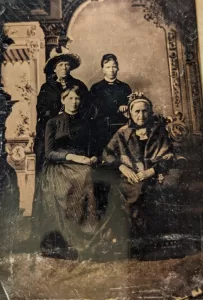
By Marilyn Karr
This is a shortened version of a book I wrote for my Dad – Michael John William “Bill” Hocks. I hope you enjoy the story.
My dad was 84 years old when I took him to Door County, Wisconsin, his roots until he was nine years old. Then the family moved to Portland in 1914.
Dad cared for my mother for 14 years. She had early-onset Alzheimer’s. Other than two trips to Anchorage and a trip to Banff and Glacier National Parks, they traveled little.
This journey takes place in 1990, about two years after my mother’s passing. Dad put much time and energy into taking care of mom. And there wasn’t enough time for him to have the quality of life he so deservedly should have had.
This being his first flight and with a window seat, Dad continually asked the same question over and over, “Where are we going?” He was geared up like a kid and wanted to know everything. He just couldn’t remember the answers.
It was early June. School not yet out, the snow had ceased, vacation season not yet begun. The weather hovered around 75-85 degrees each day, a perfect temperature to search for his roots.

Once we arrived in Green Bay and picked up the rental car, we drove to Sturgeon Bay and stayed at the “Grey Goose B&B,” a Civil War era home built in 1862. Chocked full of antiques, I wanted him to feel like it was a home like what he might remember.

Still in operation but under different management, each morning Jessie really put herself out with a gigantic breakfast, using a different color of antique glass dishes each morning. Prior to their operating the B&B, she owned an antique store.
Long before white man appeared, the Potawatomi and Menomonee Indians lived on the shores of the bay which they named for the fish that were so plentiful in its waters. Sturgeon used to be caught and piled up on the shores like cord wood. Long before this journey, Dad talked about the Indians coming to the house. His mother would go outside to meet them while their dog cowered beneath the porch.
We head to the courthouse where we attained a certified copy of Dad’s birth certificate and a certified copy of his parents’ marriage certificate (12/5/1887). I also requested a certified copy of his youngest sibling’s birth certificate. This way, I learned the ages of my grandparents at his birth, he 45 and she 40. With a 21-year-span from 1888 to 1909, she gave birth to nine children. Four children prematurely died, all less than four months old.
In chronological order, I found the certified books of marriages, births and deaths most interesting, as my Dad’s surname was mentioned often in the first section.

Sarah Hanrahan
My great great grandfather, a farmer, was born in Holland in 1821 and immigrated to Door County in 1856. He died in 1897. My great great grandmother, born in Ireland, was born in 1820 and died in 1887. According to the 1870 census, his property was valued at $1500 and his personal property at $350.
The following is an article from the “Door County Expositor, 10/31/1884, about my great great grandfather:
“Our farmer friend, John Hox, [the name seemed to be interchangeable with Hocks] of the town of Sevastapol, two years ago last spring planted one pea (it being all he had at the time) of the variety known as the ‘Little California Beauty,’ from which he raised 108, but had the bad luck to lose eight of them, leaving 100 even, which he planted the following spring, but during the season fully one-half of them were accidentally destroyed. Last spring he planted again what he had saved from the year before, and this year gathered two bushels from the planting. Thus it will seem that from one seed, in three years time, or rather three seasons, Mr. Hox, by careful husbandry, could have raised over four bushels of peas. Truly, ‘great oaks from little acorns grow.’”
The following is an excerpt from a local newspaper, “The Advocate,” Sevastopol, Wisconsin, 12/8/1880:
“The first white settler that we can get any account of was a Mr. Lovejoy, who came from Canada, and squatted on the shore of Sturgeon Bay near its mouth, and which is known as Hibbard’s Bluff, sometime in the year 1836. He remained there for some years and followed the occupation of fishing and also furnished steamboats with wood…”
Across the street from the courthouse, we visited the library which had a large genealogy department.
From a book entitled History of County, by Martin, 1881, my great great grandfather “…and a few others moved their families into the town to battle with the noble forests and the hard times that followed the panic of the fall of 1857…”
It was an unusually early winter. Sturgeon Bay stared down possible massive starvation during the panic of 1857, America’s first widespread economic depression. Supply ships were stopped by the ice and had to turn back.
“So long to be remembered by the few old settlers that first broke soil in these grand old woods.”
Stay tuned for the next column of Part II of “The Search for Roots.”
This is my fourth contribution to the “Tillamook County Pioneer.” Each time I end the column with my welcoming your comments and suggestions journey.gal@yahoo.com.


